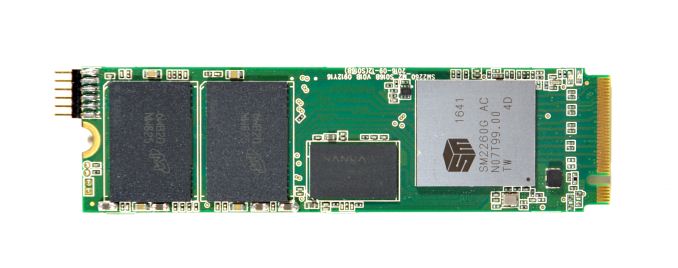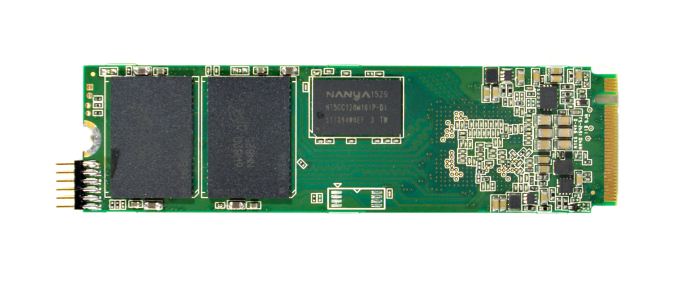Previewing Silicon Motion SM2260 NVMe Controller With 3D MLC NAND (512GB)
by Billy Tallis on February 17, 2017 9:00 AM EST
Silicon Motion's SM2260 is their first NVMe PCIe SSD controller. We've already reviewed one SSD using this controller: the Intel SSD 600p. That drive used Intel's 3D TLC NAND and set a new low for NVMe SSD prices while also offering performance that is mostly beyond the reach of any SATA SSD. Today we have an engineering sample from Silicon Motion that pairs the SM2260 controller with Micron's 3D MLC NAND—our first look at the performance of the Intel/Micron 3D MLC and a preview of what to expect from products like the ADATA XPG SX8000.
One of the first announced design wins for the SM2260 controller was Micron's Ballistix TX3 SSD, which was intended to be their first consumer PCIe SSD and a flagship product for their overhaul of the Ballistix brand. The drive was originally intended to hit the market in September 2016 but was canceled before launch. Since then, Micron has not introduced any consumer products using the MLC version of their 3D NAND, leaving the 3D TLC-based Crucial MX300 as their top consumer SSD. Intel shipped their 3D TLC-based 600p with a customized SM2260 controller, but the aging SSD 750 remains their high-end consumer NVMe offering.
With a controller that was spurned by Micron and 3D MLC NAND that its manufacturers have not tried to introduce to the consumer market, this engineering sample offers us some insight into Intel and Micron's consumer SSD strategies and the opportunity they passed up. It also offers us a preview of ADATA's XPG SX8000, their first NVMe SSD and one that is based on this controller and NAND flash combination. ADATA is the first brand to announce products with Micron's 3D MLC for the consumer market, with the XPG SX8000 NVMe SSD and the Ultimate SU900 and XPG 950 SATA SSDs, all using Silicon Motion controllers.
ADATA usually has a broader range of controller and NAND combinations than any other brand, but so far Micron is their only choice for 3D NAND for SSDs and Silicon Motion is their controller vendor. This is due in large part to Silicon Motion being the first controller vendor ready with a complete hardware and firmware reference design tuned for Micron's 3D NAND. At CES earlier this year, we also saw Mushkin announce SATA and NVMe SSDs based on the combination of Micron 3D NAND and Silicon Motion controllers.
The SM2260 controller supports a PCIe 3.0 x4 interface and implements the NVMe 1.2 protocol. The controller has a dual-core ARM Cortex-R processor and is manufactured on TSMC's 40nm LP process, an interesting juxtaposition when you consider that most of its competition is on 28nm. The controller is packaged with a thin copper heatspreader that we first saw relatively late in the chip's design cycle. LDPC error correction and TCG Opal encryption are supported.
The sample we are reviewing today is a M.2 2280 SSD with a total of 16 of Micron's 256Gb 3D MLC dies spread across four packages and the controller's 8 channels. This amount of flash would typically be used for a drive with an advertised capacity of 480GB, 500GB or 512GB, but this sample has a usable capacity closer to 515GB. This means its spare area is a little smaller than is normal—about 6.31% rather than the more common 6.85%. The firmware implements a dynamically-sized SLC cache whereas the Intel SSD 600p used a fixed-size cache.
Silicon Motion will surely face more competition this year for design wins for 3D NAND SSDs. Micron used a Marvell controller for their own Crucial MX300 SATA SSD, the only shipping SSD with Micron's 3D NAND that doesn't use a Silicon Motion controller. We expect Phison's controllers to be a popular choice once Toshiba has 3D NAND for the SSD market and Plextor is likely to continue using a mix of Marvell and Silicon Motion controllers when they begin transitioning to 3D NAND. This year we will probably also see Maxiotek score a design win for their MK8115 DRAM-less SATA SSD controller that is primarily intended for use with 3D TLC NAND. But in the meantime, Silicon Motion's SM2260 is the NVMe controller that's already shipping paired with 3D NAND.
The main competition we'll be comparing this sample against includes:
- The Patriot Hellfire 480GB, using the Phison PS5007-E7 controller and Toshiba 15nm MLC
- The Intel SSD 600p 512GB, using the SM2260 controller and Intel 3D TLC
- The Plextor M8PeG(N) 512GB, using the Marvell 88SS1093 controller and Toshiba 15nm MLC
- The Samsung 960 EVO, using Samsung 3D TLC, tested in 250GB and 1TB capacities
| AnandTech 2015 SSD Test System | |
| CPU | Intel Core i7-4770K running at 3.5GHz (Turbo & EIST enabled, C-states disabled) |
| Motherboard | ASUS Z97 Pro (BIOS 2701) |
| Chipset | Intel Z97 |
| Memory | Corsair Vengeance DDR3-1866 2x8GB (9-10-9-27 2T) |
| Graphics | Intel HD Graphics 4600 |
| Desktop Resolution | 1920 x 1200 |
| OS | Windows 8.1 x64 |
- Thanks to Intel for the Core i7-4770K CPU
- Thanks to ASUS for the Z97 Deluxe motherboard
- Thanks to Corsair for the Vengeance 16GB DDR3-1866 DRAM kit, RM750 power supply, Carbide 200R case, and Hydro H60 CPU cooler












27 Comments
View All Comments
BrokenCrayons - Friday, February 17, 2017 - link
It seems like power consumption and consistency are both problems. Consistency can probably be addressed through tuning and optimization of firmware, but power consumption is probably something that can't be fine-tuned away. NVMe drives aren't as power friendly as SATA, but the inefficiencies of some recently reviewed SSDs here on Ananatech certainly seems to throw a spotlight on the problem. Between that and thermal throttling, the NVMe storage picture isn't very rosy just yet.KAlmquist - Friday, February 17, 2017 - link
Even with 25% overprovisioning, I see a 1 second interval at the 3350 mark where the IOP's fall to zero. Fortunately, the performance consistency of this SSD seems more in line with its competitors on the trace-based benchmarks (The Destroyer, etc.).The sequential read performance at queue depth 1 is lower than that of budget SATA SSD's like the MX300. At higher queue depths, the sequential reads are faster than anything a SATA SSD can manage, but queue depths of 1 are not uncommon in a desktop environment.
vladx - Saturday, February 18, 2017 - link
Now we can see why Micron cancelled its' NVMe SSD using the SM2260, it's simply not competive.Drumsticks - Saturday, February 18, 2017 - link
So what's a good roundup conclusion on the current state of NVMe drives? If we want to pick one up this year, where does the performance go from "bad for NVMe" to "not Samsung but still pretty good!"? Plextor?vladx - Saturday, February 18, 2017 - link
Indeed Plextor M8Pe seems to be the best buy option at the moment in the NVMe space.Drumsticks - Saturday, February 18, 2017 - link
That's what I was thinking. $220/$240 for the 500GB model right now. So much more than it used to be. Do we have any news on whether anything constraining nand supply will be alleviating any time soon?vladx - Saturday, February 18, 2017 - link
The supply problems most likely will be gone after Chinese companies will flood this market in 2018. But it could happen sooner than that depending on how fast will Toshiba/Western Digital will be rolling up their own 3D NAND supply.Chaser - Saturday, February 18, 2017 - link
"and the Plextor M8Pe is very slightly faster."AbRASiON - Sunday, February 19, 2017 - link
If this is CHEAPER than an MX300 it's an incredibly good bargain. The MX300's are really really well priced. I'd consider it if it's dead, dead cheap.The 960 Evo / Pro is a joke, sure it's fast but in real world usage, it's ridiculously expensive.
Make the 1TB version of this for $250 US or less and I'm very much in. (I doubt it will though)
StrangerGuy - Sunday, February 19, 2017 - link
I know right, Techreport tested the 960 Evo/Pro are both so close to yesteryears SATA3 SSDs in real-world load times that they are easily within the margin of error. I don't care about how NVMe is able to reach uber fast raw speeds that has zero use to me or to 99% of the people out there, but a hypothetical SSD with half the raw transfer speed of current SATA3 SSDs for 2x the capacity per dollar? That's a real bargain.